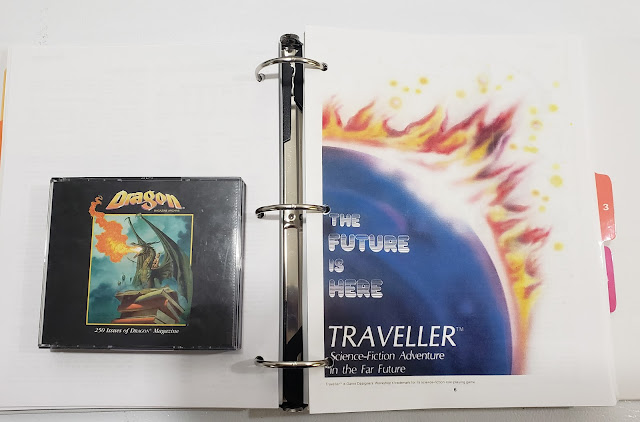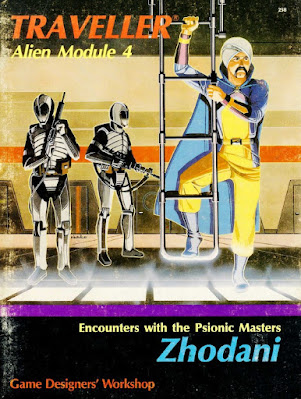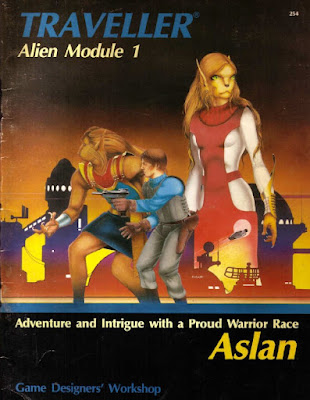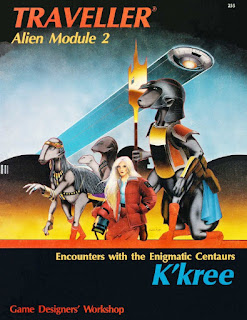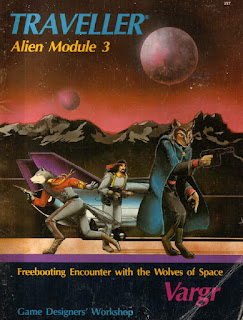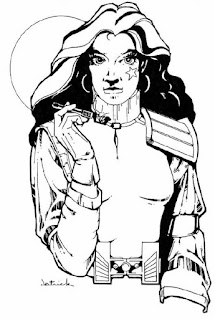I was talking with her about Sci-Fi month (she is a huge scf-fi fan) and Traveller and how I learned of the game via Dragon Magazine. She suggested that it was high time I did another "This Old Dragon" and focused on Traveller. So I have spent this week going through some of the Dragons I left and some of the articles I have already "liberated" from various Dragons.
Remember that a lot of the Dragons I have water damage or are other wise in bad shape. A few were so mildewy I dropped them in favor of the Dragon Magazine CD-ROMs.
There are a few Traveller articles, TSR/Dragon was very eager to embrace other companies' products more in the early days. This is good for me since I really wanted to focus on Classic Traveller.
I am not going to hit *every* Dragon article about Traveller, but I do want to hit the big ones. I am, for obvious reasons, going to feature the ones I still have in my collection.
The Dragon Days
William B. Fawcett is up first with The Asimov Cluster in The Dragon #20. This area of space is an attempt to emulate various Science Fiction novels while keeping everything within the scope of Traveller. There are 10-star systems described here. I have the feeling that if I had read more classic sci-fi I might recognize these worlds a bit better.
The Dragon #25 has New Service Options for Navy Characters by R.D. Stuart. Now the date on this is May 1979 so I am not sure what is happening with the Supplements at this time so no idea if this information had been rendered redundant at any point. I will assume it had at some point. But until then it is not a bad set of charts. If you are still using the 3 LBBs this is still good stuff.
We move on to The Dragon #27 and two articles from Gary Jordan. Up first he gives us another take on his Tesseracts article from TD #17 (and famously in The Best of Dragon II). Where that article was used to confuse map mappers, here it is a boon in Traveller since the area is hyperdimensional. What does that mean for Traveller characters? You can cram more into your hold. This is followed by a Star System Generation system.
The Dragon #35
This is the first of a couple of Traveller-themed issues. This one comes to us from March 1980. We get an article on the "Space FBI" from Kenneth Burke in IBIS: Profit and Peril. Alexander von Thorn, famous for his "Politics of Hell" article, is up with one of two articles on new skills. The other is from Charles Ahner & Rick Stuart. More Clout for Scouts from Anthony Previte and Jame Cavaliere is next and establishes that this article, in particular, takes Mercenary into consideration. The Traveller universe is growing! In a switch from characters, James Hopkins is next with Block Holes! about, well, Black Holes. This one would have been very welcome to me back then having just seen the Disney "Black Hole" movie at the "67 Drive-In Theatre" back in 79.
This was 1980 though. I was firmly entrenched in my newest obsession, Dungeons & Dragons, and I barely knew other games existed, yet.
Dragon #51
The next, and also sadly the last, issue to have a Traveller featured section was Issue #51 from July 1981. Though there is a lot here. And a lot of that is quality.
The heading for this feature is "The Future is Here." Trust me living in the 80s felt like the future was just right around the corner. No wonder Traveller attracted me so.
Up first we have Dragon vet Roger E. Moore with Make Your Own Aliens. The Aslan and Vargr are still a bit off for Traveller fans at this point, but Moore takes Andy Slack's article series from White Dwarf #13 to #16 and expands on it. The article is interesting and feels a little more like a "create your own monster" for D&D or mutant for Gamma World. The rolls on the charts are d% and not d66. On the plus side it would also work for something like Gamma World or Star Frontiers.
I do find it entertaining that the art for this article features what can only be described as "Dralasites."
Jeff Swycaffer is next with Plotting a Course for Choosy Players. This takes out some of the randomnesses of character generation by adding a Point-Buy system. It looks like it could work well enough and I am sure something similar was added to future versions of Traveller. Point-Buy systems were all the rage in the 1990s.
Paul Montgomery Crabaugh is up with a few articles. First is New Ideas for Old Ships. The art and the article give this a full "Used Cars" feel to these ships, but to be honest this feels right. Characters just completing their terms of service are not going out to buy a brand new Porsche 911 with the heated leather seats, heads-up display, and personal wifi. No, they are getting an 11-year-old Honda Civic with all after-market parts and a rattle that no one can figure out.
Next, he gives us In Defense of Computers and tackles the two biggest issues people had with computers then; they are too expensive and do too little. First I never felt the computers in Traveller were too expensive, at least not for what they are supposed to do on a Starship. I do agree they do too little by today's standards. But anymore I of the frame of mind there are computers in Traveller and there are Computers.
Crabaugh delivers two shorter articles. The first is Planet Parameters which details various features, mostly gravity, of an alien world. It works...for the game, but actual stellar data is wildly different. I think we are fine with the size, G, Vesc, and Mass columns, but the P (rotational period) we know can vary wildly. Earth and Venus are roughly the same size (say Size 8 and 7 respectively). Earth's rotational period is 23 hours, 56 minutes, or one day. Venus has a P of 116 days, 18 hours. Mars, a Size 4 or 5 planet has a P (day) of 24 hours, 37 minutes. Jupiter, which is off this scale, has an M of 317 (the chart goes to 2.4) and a P of 10. In his defense, he does say that rotational periods can be slowed due to gravity. The Earth's is slowed by our relatively large moon, Venus by the Sun and Mars none really at all.
Next, he deals with Masers, or microwave band lasers (and points out the lasers are really visible light masers, but hey).
Lastly, we get an article from none other than Marc Miller. The Miller Milk Bottle is, I think, an attempt to be the Towel of Hitchhikers Guide to the Galaxy for Traveller. Half a page on how useful the mundane milk bottle is.
The Jon Mattson Articles
Over the next several months we get a number of articles from Jon Mattson. These are also usually longer articles and add more details to your Traveller game.
Filling in Skills from Dragon #55 does exactly that. This one details a "learning by doing" system of skill improvement. I never got to play enough games to know what my character would have done long-term. So I have no practical experience here.
Moving on to February of 1982 in Dragon #58 we have Anything But Human, another attempt at creating aliens for Traveller. Again this one is heavy on the d% rolls.
Later that year in August we get Robots in Dragon #64, with some nice Larry Elmore art showing us where the VR-X9-4-M2 Galactic Probe, Government Issue Robot was made. Like the Alien article above it has a lot of random tables. Also it could be used with Star Frontiers if you wanted to.
The Luna Series
In the early to mid 80s Dragon's Ares Section, which was devoted to Sci-fi, ran a series of articles on Luna, the Moon, and how it fit into various science fiction games. I thought it was a great series and I loved reading all the different takes on it. It had a side effect on my developing the moons of my D&D worlds in more detail. But today we are looking at Dragon #87 and Luna: A Traveller's Guide by the first Traveller himself Marc Miller. Note this article was copyrighted 1984 by GDW, so I imagine this is as close to official as it could get. It is a library computer readout of Luna and it's place in the Imperium and to Terra.
The Later Years
Post-1984 Traveller and all sci-fi began to see subtle changes. These would be complete by the late 1980s and early 90s when Sci-Fi became darker and more cyberpunk. I enjoyed the change myself, but also at this time I was drifting away from sci-fi and fantasy and more into dark fantasy and horror.
A sign of the times could be seen in Igor Greenwalds' Rogues of the Galaxy in Dragon #97 (May 1985). Called a character "class" these are essentially characters who came up via organized crime instead of military, merchant, or other services. It also features art from Jim Holloway, so maybe a sign of MegaTravller to come?
We get more Jim Holloway art in September of the same year (Dragon #101) with The Stellar Diocese from Michael Brown. I know as a D&D player I talked about my Traveller Envy before. But I am getting some serious "D&D Envy" from the Traveller fans here. Or...maybe these are the articles that Dragon printed since they knew they might appeal to D&D fans.
High Tech and Beyond from James Collins in Dragon #108 discuss some issues that were brought up all the way back to The Dragon #20 and that is that a lot of sci-fi media is much higher tech than the TL 16 depicted in Traveller. This article introduced some things that we take for granted in scifi like planet-destroying weapons, antimatter and transporters.
Michael Brown is back in Dragon #109 with The Double-Helix Connection or Mutants in Traveller. Gamma World Envy?
Put on "Bad Boys" because Terrence R. McInnes gives us Star Cops! in Dragon #113. This article is also one of the reasons why I don't have a Dragon CD-ROM for issues past 250. This article is copyrighted by McInnes, so likely there were never any second-run or reprintings allowed. Anyway, this article deals with character creation for police forces. It actually looks rather fun. This one also cites an earlier article from The Journal of the Travellers' Aid Society #14. That is an entire universe left unexplored at present by me!
So we have done Gamma World and D&D with Traveller, why not Top Secret? John Dunkelberg, Jr. has Space-Age Espionage in Dragon #120. This is presented as a new career (not class) for Traveller characters. The article is in-depth and in my very untrained eye, it looks like it could work out well. Interestingly enough the following article is from Douglas Niles about the new Top Secret game.
This is also the last article in Dragon about Traveller until Dragon #270 (April 2000) and even then it is only to convert it to Alternity.
1987 is my personal cut-off date for Classic Traveller. I am sure others share that, but 87 was also the year I went to University and my tastes moved from Sci-fi to Horror. I still LOVED Star Trek and that was the bulk of my sci-fi roleplaying. These last two weeks have given me so much Traveller information that I honestly could stop right here and be very happy. But I have to admit there is Traveller 2300, MegaTraveller, T5, T20, and more out there I need to learn about and figure out.
This is going to be a fun trip.




